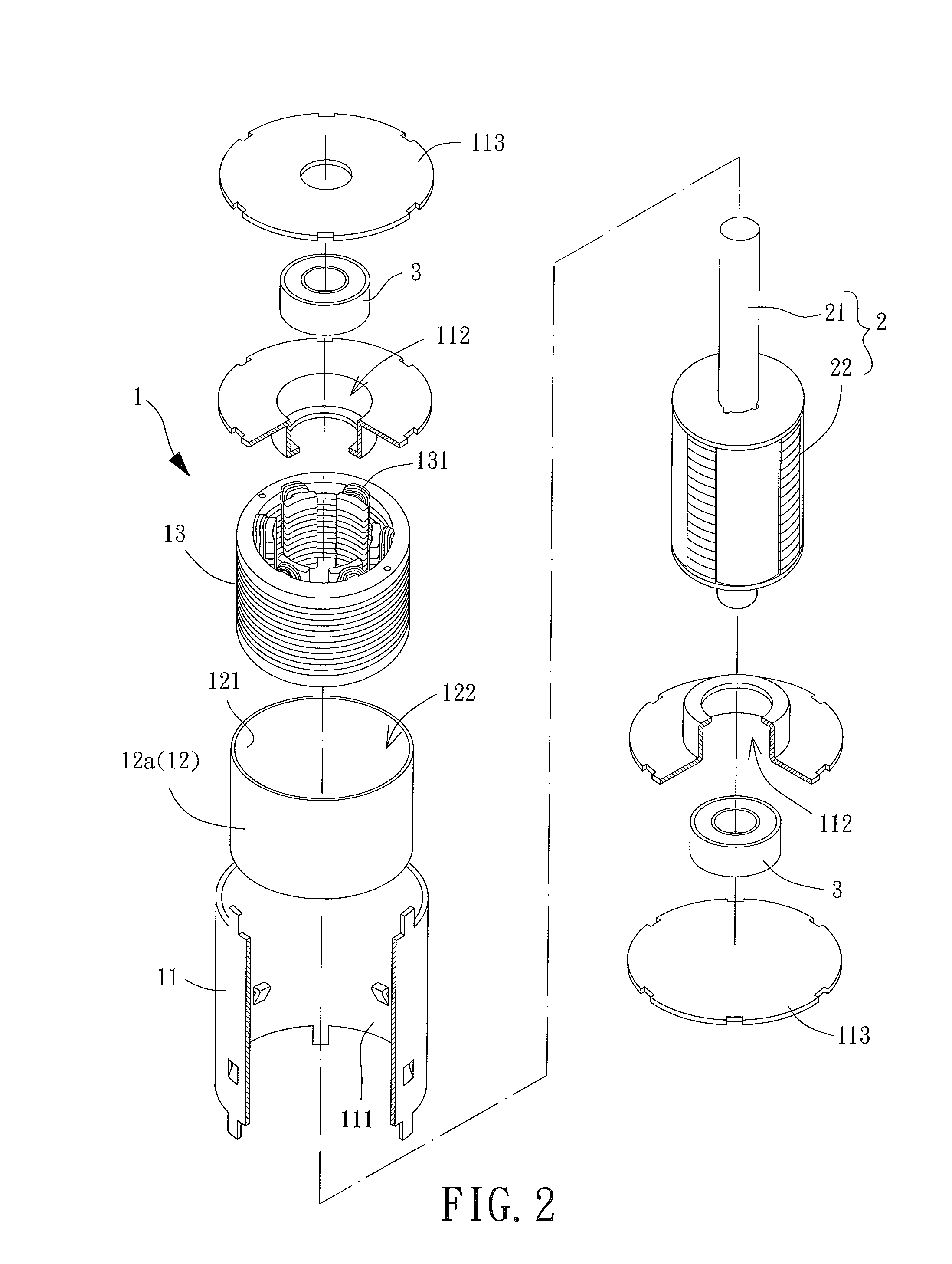Inner-Rotor Motor
a technology of inner-rotor motor and inner-rotor motor, which is applied in the direction of dynamo-electric machines, magnetic circuit rotating parts, and shape/form/construction of magnetic circuits, etc., can solve the problems of significant reduction of inner-rotor motor safety, adverse effects on and inability to operate normally. to achieve the effect of improving the operational stability of inner-rotor motor
- Summary
- Abstract
- Description
- Claims
- Application Information
AI Technical Summary
Benefits of technology
Problems solved by technology
Method used
Image
Examples
first embodiment
[0039]Please refer to FIGS. 2 and 3, an inner-rotor motor according to the present invention includes a stator 1 and a rotor 2 rotatably coupled to the stator 1.
[0040]The stator 1 includes a housing 11, an insulating layer 12 and an iron core 13. The insulating layer 12 is arranged between the housing 11 and the iron core 13, and the housing 11 is usually made of metal. In this embodiment, the insulating layer 12 includes an insulating member 12a, which is a substantially insulating structure made of an insulating material, such as an insulating sleeve, an insulating cover or an insulating shell. As such, the insulating member 12a may be coupled with the housing 11, and the iron core 13 couples with an inner periphery of the insulating member 12a. The housing 11 includes an inner surface 111 for coupling with the insulating member 12a. The iron core 13 may be coupled to a coupling surface 121 of the insulating member 12a facing away from the housing 11. Specifically, a through hole ...
third embodiment
[0049]Please refer to FIG. 5, an inner-rotor motor according to the present invention also includes a bobbin 123. The inner-rotor motor of this embodiment differs from the two embodiments described above in that the bobbin 123 includes a top bobbin 123a and a bottom bobbin 123b jointly holding the iron core 13 in place from two ends of the iron core 13. Each of the top bobbin 123a and the bottom bobbin 123b may be integrally formed on the insulating layer 12 and may form a recess 124 for positioning the coil 131 on the iron core 13.
[0050]As such, in both the second and third embodiments of the present invention, the insulating layer 12 separates the iron core 13 from the housing 11 along the radial direction of the housing 11. Besides, the insulating layer 12 further includes the bobbin 123 that positions the coil 131 on the iron core 13, thus reducing the production cost of the inner-rotor motor. The top bobbin 123a and the bottom bobbin 123b of the bobbin 123 may be integrally for...
fourth embodiment
[0053]Please refer to FIG. 6, in an inner-rotor motor according to the present invention, the stator 1 also includes a housing 11, an insulating layer 12 and an iron core 13. The insulating layer 12 is radially arranged between the housing 11 and the iron core 13. The inner-rotor motor of this embodiment differs from those embodiments above in that the insulating layer 12 includes an insulating member 12a and an air layer 12b. Specifically, the insulating member 12a is coupled to an inner surface 111 of the housing 11 and includes two ends each being coupled with a connecting portion 126. The connecting portion 126 includes two ends respectively coupled with the insulating member 12a and the iron core 13 and extends along a radial direction of the shaft 21 for separating the insulating member 12a and the iron core 13 from each other. Thus, a gap is formed between the iron core 13 and a coupling surface 121 of the insulating member 12a facing away from the housing 11. The air layer 1...
PUM
 Login to View More
Login to View More Abstract
Description
Claims
Application Information
 Login to View More
Login to View More - R&D
- Intellectual Property
- Life Sciences
- Materials
- Tech Scout
- Unparalleled Data Quality
- Higher Quality Content
- 60% Fewer Hallucinations
Browse by: Latest US Patents, China's latest patents, Technical Efficacy Thesaurus, Application Domain, Technology Topic, Popular Technical Reports.
© 2025 PatSnap. All rights reserved.Legal|Privacy policy|Modern Slavery Act Transparency Statement|Sitemap|About US| Contact US: help@patsnap.com



